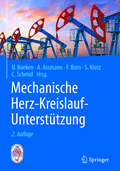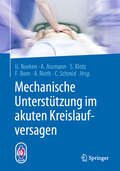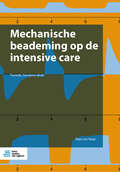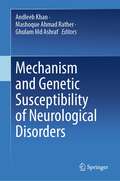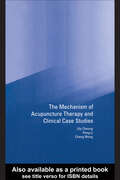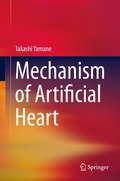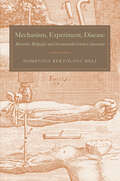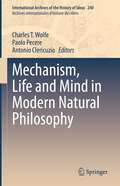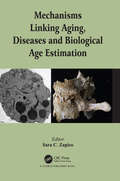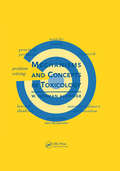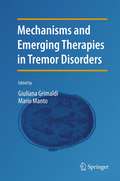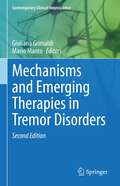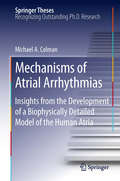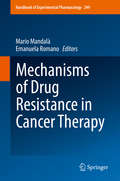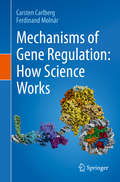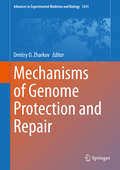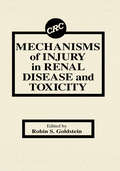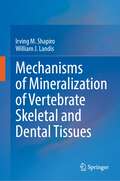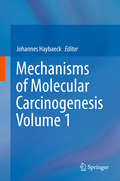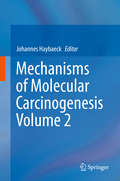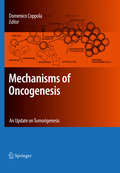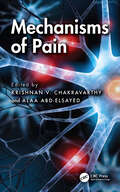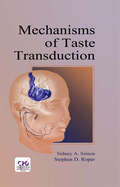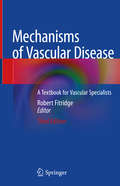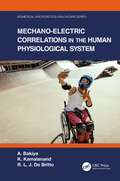- Table View
- List View
Mechanische Herz-Kreislauf-Unterstützung
by Stefan Klotz Udo Boeken Alexander Assmann Frank Born Christof SchmidDer aktuelle Stand der mechanischen Herz-Kreislauf-Unterstützung ist in übersichtlicher Form in diesem Buch zusammengefasst. Die einzelnen verwendeten Systeme werden ebenso von Experten in Wort und Bild dargestellt wie die Indikationsstellung, die Nachsorge und mögliche Komplikationen. Neu in der 2., durchgehend aktualisierten Auflage sind Kapitel zur psychologischen Versorgung von VAD-Patienten, zur ECLS/ECMO bei Kindern und zu aktuellen Weiterentwicklungen im VAD-, aber auch TAH-Sektor; das Kapitel zum Komplikationsmanagement wurde erweitert.
Mechanische Unterstützung im akuten Kreislaufversagen
by Stefan Klotz Udo Boeken Alexander Assmann Frank Born Christof Schmid Andreas RiethZur Überbrückung eines akuten Kreislaufversagens wurden in den letzten Jahren unterschiedliche Unterstützungssysteme mit spezifischen Vorzügen und Nachteilen entwickelt. Das Prinzip, die Indikationen zur Anwendung und mögliche Risiken und Komplikationen aller angewandten Systeme (IABP, Impella, TandemHeart, Zentrifugalpumpen, va-ECMO) sind anschaulich und mit zahlreichen Abbildungen von Experten beschrieben. Grundlagenthemen wie die Pathophysiologie des Schocks und das Gerinnungsmanagement werden ebenso berücksichtigt wie spezielle Anwendungen bei Kindern oder für den Patiententransport.
Mechanische beademing op de intensive care
by Hans ter HaarDit boek geeft een volledig en evidence-based overzicht van alle facetten van mechanische beademing. Het biedt de zorgprofessional inzicht in de verschillende beademingsvormen; de werkingsmechanismen, hoe ze optimaal kunnen worden toegepast, welke invloed ze uitoefenen op de longen en de rest van het lichaam en wat de gevolgen hiervan kunnen zijn. Mechanische beademing op de intensive care behandelt onder meer anatomie, fysiologie, pathofysiologie, respiratoire insufficiëntie, beademingsvormen, curves en loops, het instellen van de beademingsmachine, beademingsstrategieën en -technieken, complicaties en andere gevolgen, capnografie en ontwennen van beademing. Het boek gaat waar nodig diep op de materie in met inzichten uit de meest recente studies. Mede dankzij de vele afbeeldingen is het zeer leesbaar en toegankelijk.Nieuw in deze editie zijn onder andere Covid-19 ARDS, patient-self-inflicted-lung-injury, airway pressure release ventilation, mechanical power, gepersonaliseerd beademen, en nieuwe technieken om de mate van longstress te bepalen.Dit boek is een must voor iedereen die met mechanische beademing werkt, van IC-verpleegkundigen (in opleiding), beademingsspecialisten (in opleiding), tot artsen in opleiding en vele andere professionals die met mechanische beademing werken.Hans ter Haar is werkzaam als IC-verpleegkundige en beademingsspecialist in Isala Zwolle.
Mechanism and Genetic Susceptibility of Neurological Disorders
by Ghulam Md Ashraf Andleeb Khan Mashoque Ahmad RatherThis book is about the "Mechanism and Genetic susceptibility of Neurological disorders. It is a comprehensive exploration, penned by esteemed authors, and offers a profound understanding of these enigmatic ailments, their progression, and the strategic approaches employed to mitigate their impact. In this book, readers will uncover a wealth of knowledge surrounding the mechanistic intricacies that underlie various neurological disorders. Through meticulous research and insightful analysis, the authors elucidate the inner workings of these conditions, shedding light on the mechanisms responsible for their onset and progression. The central themes of this book are the recognition of the genetic landscape governing neurological disorders. It emphasizes the role played by a diverse array of genes in the development and progression of these conditions, highlighting the multifaceted genetic susceptibility that underlies their manifestation.
Mechanism of Acupuncture Therapy and Clinical Case Studies
by Peng Li Lily Cheung Cheng WongAn informative and provocative text, this book describes the current status of knowledge and challenges scientists to better define acupuncture therapy. The first section covers the scientific basis and mechanism of acupuncture, particularly in relation to the cardiovascular system. The second section is devoted to clinical case studies, illustrating that scientific knowledge can be integrated with traditional concepts in Chinese medicine to provide effective treatments. It is a useful reference guide for advanced students and practitioners of traditional Chinese medicine and acupuncture, as well as scientists conducting physiological and pharmacological research.
Mechanism of Artificial Heart
by Takashi YamaneThis book first describes medical devices in relation to regenerative medicine before turning to a more specific topic: artificial heart technologies. Not only the pump mechanisms but also the bearing, motor mechanisms, and materials are described, including expert information. Design methods are described to enhance hemocompatibility: main concerns are reduction of blood cell damage and protein break, as well as prevention of blood clotting. Regulatory science from R&D to clinical trials is also discussed to verify the safety and efficacy of the devices.
Mechanism, Experiment, Disease: Marcello Malpighi and Seventeenth-Century Anatomy
by Domenico Bertoloni MeliA leading early modern anatomist and physician, Marcello Malpighi often compared himself to that period’s other great mind—Galileo. Domenico Bertoloni Meli here explores Malpighi’s work and places it in the context of seventeenth-century intellectual life.Malpighi’s interests were wide and varied. As a professor at the University of Bologna, he confirmed William Harvey’s theory of the circulation of blood; published groundbreaking studies of human organs; made important discoveries about the anatomy of silkworms; and examined the properties of plants. He sought to apply his findings to medical practice. By analyzing Malpighi’s work, the author provides novel perspectives not only on the history of anatomy but also on the histories of science, philosophy, and medicine. Through the lens of Malpighi and his work, Bertoloni Meli investigates a range of important themes, from sense perception to the meaning of Galenism in the seventeenth century. Bertoloni Meli contends that to study science and medicine in the seventeenth century one needs to understand how scholars and ideas crossed disciplinary boundaries. He examines Malpighi’s work within this context, describing how anatomical knowledge was achieved and transmitted and how those processes interacted with the experimental and mechanical philosophies, natural history, and medical practice. Malpighi was central in all of these developments, and his work helped redefine the intellectual horizon of the time. Bertoloni Meli’s critical study of this key figure and the works of his contemporaries—including Borelli, Swammerdam, Redi, and Ruysch—opens a wonderful window onto the scientific and medical worlds of the seventeenth century.
Mechanism, Life and Mind in Modern Natural Philosophy (International Archives of the History of Ideas Archives internationales d'histoire des idées #240)
by Charles T. Wolfe Paolo Pecere Antonio ClericuzioThis volume emphasizes the diversity and fruitfulness of early modern mechanism as a program, as a concept, as a model. Mechanistic study of the living body but also of the mind and mental processes are examined in careful historical focus, dealing with figures ranging from the first-rank (Bacon, Descartes, Spinoza, Cudworth, Gassendi, Locke, Leibniz, Kant) to less well-known individuals (Scaliger, Martini) or prominent natural philosophers who have been neglected in recent years (Willis, Steno, etc.). The volume moves from early modern medicine and physiology to late Enlightenment and even early 19th-century psychology, always maintaining a conceptual focus. It is a contribution to a newly active field in the history and philosophy of early modern life science. It is of interest to scholars studying the history of medicine and the development of mechanistic theories.
Mechanisms Linking Aging, Diseases and Biological Age Estimation
by Sara C. ZapicoThis book focuses on four of the hallmarks of aging: aspartic acid racemization, advanced glycation end products, telomere shortening and mitochondrial mutations; describing their role in aging and diseases; and their application to age-at-death estimation in forensic sciences in greater depth, displaying the interconnecting pathways among these processes. An additional chapter related to Epigenetics and its role in aging, diseases, and forensic age estimation is also included. This book is aimed at a broad audience: from students being introduced to aging, diseases, and forensic science research to scientists in biomedicine and forensics complementing their knowledge in their respective fields while also increasing their knowledge in other disciplines.
Mechanisms and Concepts in Toxicology
by W. Norman AldridgeIllustrating concepts and types of toxicity from a mechanistic point of view, this book focuses on research procedures in toxicology. The book uses examples of chemical intoxicants to illustrate mechanisms in each stage of toxicity.
Mechanisms and Emerging Therapies in Tremor Disorders
by Mario Manto Giuliana GrimaldiTremor is intimately linked to the numerous interactions of the central and peripheral nervous system components tuning motor control, from the cerebral cortex up to the peripheral effectors. Activities of central generators, reflex loop delays, inertia, stiffness and damping are all factors influencing features of tremor. This book discusses the pathophysiology of tremor including membrane mechanisms and rodent models, the advances in genetics and the musculoskeletal models pertinent to body oscillations. The main forms of tremor encountered during clinical practice are considered, taking into account neuroimaging aspects. The book covers recent advances in methodologies and techniques of assessment, and provides practical informations for the daily management. In addition to pharmacological treatments, neurosurgical approaches such as deep brain stimulation (DBS) and thalamotomy are discussed. Emerging techniques under development are also introduced. Future challenges are also presented.
Mechanisms and Emerging Therapies in Tremor Disorders (Contemporary Clinical Neuroscience)
by Mario Manto Giuliana GrimaldiTremor is intimately linked to the numerous interactions of the central and peripheral nervous system components tuning motor control, from the cerebral cortex to the peripheral effectors. Activities of central generators, reflex loop delays, inertia, stiffness, and damping are all factors that influence the features of tremor. This completely updated new edition discusses the pathophysiology of tremor, including membrane mechanisms and rodent models, the advances in genetics, and the musculoskeletal models pertinent to body oscillations. The main forms of tremor encountered during clinical practice are considered, taking into account neuroimaging aspects. The book covers recent advances in methodologies and techniques of assessment and provides practical information for daily management. This new edition is informed by the guidelines of the Tremor Task Force of the International Parkinson and Movement Disorders Society. New chapters include Classification of Tremors, Medically Induced Tremors, Resting State fMRI, and Gabaergic Pathways. In addition to pharmacological treatments, neurosurgical approaches such as deep brain stimulation (DBS) and thalamotomy are discussed. Emerging techniques under development are also introduced.
Mechanisms of Atrial Arrhythmias
by Michael A. ColmanThis thesis describes the development of biophysically detailed computer models of the human atria and torso to study the underlying mechanisms of cardiac diseases, some of the most common causes of morbidity and mortality. This is a cross-disciplinary project, involving fundamentals of cardiac electrophysiology, physics of excitable media, applied mathematics and high performance scientific computing and visualisation. The author uses computer models to provide insights into the underlying mechanisms of the genesis of atrial fibrillation and develops novel techniques for the monitoring of atrial tachycardia.
Mechanisms of Drug Resistance in Cancer Therapy (Handbook of Experimental Pharmacology #249)
by Mario Mandalà Emanuela RomanoA major objective of this book is to reveal unprecedented opportunities to understand and overcome drug resistance through the clinical assessment of rational therapeutic drug combinations and the use of predictive and prognostic biomarkers to enable patient stratification and tailor treatments. It offers to the readers an updated overview on the possible reasons of failure of new and promising therapeutic opportunities.
Mechanisms of Gene Regulation: How Science Works
by Carsten Carlberg Ferdinand MolnárThis textbook aims to describe the fascinating area of eukaryotic gene regulation for graduate students in all areas of the biomedical sciences. Gene expression is essential in shaping the various phenotypes of cells and tissues and as such, regulation of gene expression is a fundamental aspect of nearly all processes in physiology, both in healthy and in diseased states. Th is pivotal role for the regulation of gene expression makes this textbook essential reading for students of all the biomedical sciences, in order to be better prepared for their specialized disciplines. A complete understanding of transcription factors and the processes that alter their activity is a major goal of modern life science research. The availability of the whole human genome sequence (and that of other eukaryotic genomes) and the consequent development of next-generation sequencing technologies have significantly changed nearly all areas of the biological sciences. For example, the genome-wide location of histone modifications and transcription factor binding sites, such as provided by the ENCODE consortium, has greatly improved our understanding of gene regulation. Therefore, the focus of this book is the description of the post-genome understanding of gene regulation.
Mechanisms of Genome Protection and Repair (Advances in Experimental Medicine and Biology #1241)
by Dmitry O. ZharkovDNA is under constant challenge from environmental and endogenous metabolic assaults. Several layers of defence and repair systems allow cells to maintain stable genomes; in humans, dysfunction of these systems leads to cancer, neurodegeneration, and other pathologies. At the same time, recently it had emerged that targeted and regulated DNA damage and repair is a mechanism underlying several important cellular processes such as epigenetic demethylation and immunoglobulin gene diversification. The present collection of papers is aimed to cover new developments in the area of protective and regulatory mechanisms associated with DNA damage. The mechanisms ruling the recognition of damaged nucleotides against the vast background of normal ones are reviewed. The role of extended non-catalytic domains that are often found in eukaryotic DNA repair proteins in contrast to their downsized, catalytic-only bacterial counterparts is discussed. Among the proposed subjects are the regulatory functions of bulky covalent modifications such as poly(ADP)ribosylation and ubiquitylation in DNA damage response, especially in the context of chromatin remodelling. As opposed to DNA repair, damage tolerance allows cells to replicate with lesions in the genome; the enzymes responsible are also covered. Finally, we present examples of modern multilevel understanding of the cell function and malfunction in the wake of genotoxic assaults such as oxidative stress, abiotic environmental stress, and DNA-damaging plant toxins.
Mechanisms of Injury in Renal Disease and Toxicity
by Robin S. GoldsteinDr. Goldstein has authored more than 50 publications and co-edited two books. Her latest contribution to the field of nephrology, Mechanisms of Injury in Renal Disease and Toxicity, promotes an understanding of the pathophysiologic mechanisms mediating renal dysfunction in disease. It provides an important perspective in understanding mechanisms of chemically induced renal injury. Over the past decade, understanding of the pathophysiologic and molecular basis of renal disease has grown tremendously. New and evolving concepts on the pathophysiology of glomerulonephritis, chronic glomerular injury, diabetic nephropathy, and acute renal failure are changing the clinical management of these disease states.
Mechanisms of Mineralization of Vertebrate Skeletal and Dental Tissues
by Irving M. Shapiro William J. LandisThe book presents a multi-disciplinary approach to understanding mechanisms regulating the formation of mineral in vertebrate skeletal and dental tissues. The focus of the book is directed toward the mineralization process, an evolutionarily conserved system in which cells synthesize a complex and unique extracellular matrix into which mineral is deposited. Regulatory control is viewed though lenses that emphasize the genetic, physical-chemical, biochemical, structural, cellular and extracellular aspects of the mineralization process as they relate to crystal nucleation, growth and maturation. Throughout the book, defects in regulation at the genetic and transcriptional levels are linked to the numerous clinical problems associated with the mineralization of bone, cartilage, tendon, tooth, and soft tissues. The book serves as a comprehensive text for basic scientists and scholars working in the many areas that comprise hard tissue research, as well as undergraduate and graduate students, postdoctoral fellows and those contemplating working in the field of biomineralization or who need a review of a specific mineralization topic. The information contained in the book is relevant for clinicians and clinical scientists in the fields of orthopaedic surgery, veterinary medicine, dentistry, endocrinology, aging and genetics.
Mechanisms of Molecular Carcinogenesis – Volume 1
by Johannes HaybaeckDivided into two volumes the work offers a so far unmatched broad and at the same time deep knowledge on molecular and cellular mechanisms of carcinogenesis and offers comprehensive insight into clinical, therapeutic and technological aspects. This 1st Volume presents tumor entities of the ocular system, the thyroid organ, the oesophagus, gliomas, non-glial brain tumors, head and neck as well as lung cancer. In addition it also discusses in-depth potential novel molecular players and the role of stem cells as well as the endocannabinoid system in carcinogenesis, it furthermore explains tumor metabolism components and signaling pathways. Each of the chapters discusses potential therapeutic strategies and novel drug targets. The book addresses basic scientists and medical researchers interested in translational cancer research.
Mechanisms of Molecular Carcinogenesis – Volume 2
by Johannes HaybaeckTogether with Volume 1, this book provides an inclusive overview of the molecular and cellular mechanisms of carcinogenesis and offers comprehensive insights into related clinical and therapeutic aspects. This second volume complements the first by presenting and concisely explaining the carcinogenesis of various tumor entities such as non-melanoma skin cancers, bone and soft tissue tumors, pancreatic cancers, hepatocellular cancer and neuroendocrine tumors. As in volume one, each chapter illuminates the similarities and dissimilarities of changed signaling pathways in the different organ systems and depicts potential therapeutic strategies. The focus of volume two lies on the presentation of modern molecular biological techniques for diagnosis, as well as strategies for biomarker identification and validation. Furthermore, it discusses potential therapeutic targets and individualized treatment strategies, offering a valuable resource for all basic scientists and medical researchers interested in translational cancer research.
Mechanisms of Oncogenesis
by Domenico CoppolaThis volume is part of a book series that was first published in 10-volumes by Kluwer in 1989 under the series editorship of Professor Hans E. Kaiser, D.Sc., former Professor of Pathology at the School of Medicine, University of Maryland at Baltimore, MD, USA along with other leaders in the field of Cancer. In order to encompass the growing body of knowledge on various aspects of cancer growth and progression since then, the series has now been expanded to 17 volumes. This volume is a comprehensive update on the mechanisms of tumorigenesis, and includes the advances in the field, as provided by the use of the most recent molecular techniques (microarray, proteomic, and other omics). While the first portion of the book contains chapters discussing pediatric cancer, the influence of environmental factors and oncogene activity in tumorigenesis, the second portion of the book is structured by organ sites (Esophagus, Breast, Pancreas, Colon, Lung, Prostate, Skin, Brain, Endocrine System, Lymphoid System, Bone, Head and Neck, and Cervix). This format provides the reader with easy access to the needed information. This definitive text will offer the medical professionals, whether in research, academia or clinical practice, the latest information endorsed by the world renowned contributors. The broad range of topics will make this a valued reference and provide a wealth of information, making this a "state of the science" on carcinogenesis.
Mechanisms of Pain
by Alaa Abd-Elsayed Krishnan V. ChakravarthyPain is a serious health problem. This book presents an intensive review of the anatomy, physiology, and pharmacology of the systems that mediate nociceptive processing. The authors cover areas that include anatomy, central and peripheral nerve processing, tissue and nerve injury states, as well as preclinical and clinical models of pain. Mechanisms of Pain also covers important clinical concepts, with specific emphasis on mechanisms of action. Written by world renowned global faculty, this book covers important areas of science required to understand pain medicine. Important topics covered include post–tissue and nerve injury pain states of primary afferents and the spinal cord. The authors also cover mechanisms of action of clinically relevant analgesics (opiates and non-opiates), psychological aspects of pain, pathophysiology of migraines, as well as the genetics of pain. This comprehensive book is to guide undergraduate, graduate, and clinicians in the field of pain medicine on important concepts related to the science and practice of pain.
Mechanisms of Taste Transduction
by Sidney A. Simon Stephen D. RoperMechanisms of Taste Transduction introduces a number of topics essential to a complete understanding of taste. These topics range from the control of food intake to the biophysical mechanisms of transduction and the design of food flavors in the food industry. The responses and organization of special sensory pathways are described in regard to the
Mechanisms of Vascular Disease: A Textbook for Vascular Specialists
by Robert FitridgeThis extensively revised third edition provides a practically applicable guide to the pathophysiology, assessment and management of vascular disorders encountered in vascular surgical practice. It features detailed information on the latest developments in the pathophysiology of conditions including atherosclerosis, multi-organ failure, limb compartment syndromes and Raynaud’s phenomenon in a clear easy to digest format. Disorders such as reperfusion injuries, vasculitides, and aortic dissection are covered. Furthermore, key topics in vascular and endovascular practice such as radiation biology and radiation safety are also detailed. Each chapter contains a set of learning objectives and key references, enabling the reader to quickly identify key points.Mechanisms of Vascular Disease: A Textbook for Vascular Specialists comprehensively covers a variety of common and unusual pathophysiologies encountered in vascular surgery, and is an ideal resource for both the trainee, and practicing clinical vascular surgeon seeking an up-to-date resource on the topic.
Mechano-Electric Correlations in the Human Physiological System (Biomedical and Robotics Healthcare)
by K. Kamalanand A. Bakiya R. L. De BrittoThe aim of Mechano-Electric Correlations in the Human Physiological System is to present the mechanical and electrical properties of human soft tissues and the mathematical models related to the evaluation of these properties in time, as well as their biomedical applications. This book also provides an overview of the bioelectric signals of soft tissues from various parts of the human body. In addition, this book presents the basic dielectric and viscoelastic characteristics of soft tissues, an introduction to the measurement and characteristics of bioelectric signals and their relationship with the mechanical activity, electromyography and the correlation of electromyograms with the muscle activity in normal and certain clinical conditions. The authors also present a case study on the effect of lymphatic filariasis on the mechanical and electrical activity of the muscle. Features: Explains the basics of electrical and mechanical properties of soft tissues in time and frequency domain along with the mathematical models of soft tissue mechanics Explores the correlation of electrical properties with the mechanical properties of biological soft tissues using computational techniques Provides a detailed introduction to electrophysiological signals along with the types, applications, properties, problems and associated mathematical models Explains the electromechanics of muscles using electromyography recordings from various muscles of the human physiological system Presents a case study on the effect of lymphatic filariasis on the mechanical and electrical activity of the muscle Mechano-Electric Correlations in the Human Physiological System is intended for biomedical engineers, researchers and medical scientists as well graduate and undergraduate students working on the mechanical properties of soft tissues.
